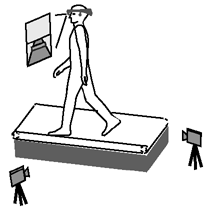1996 Project Reports
|
 |
Obstacle Avoidance - training with computer simulated
environments
David A. Brown, PhD; David L. Jaffe, MS; Sandy Dunn
Gabrielli, BS; Douglas Schwandt, MS; and James Anderson, JEM
Objective - This pilot project pursues development
of a technique to monitor, train, and improve stepping-over responses (SOR) to
typical hazards encountered during walking. Targeting persons at risk of
falling, the specific objective is to simulate important characteristics of
obstacles encountered during walking so as to elicit SOR that are appropriate
for the avoidance of tripping and/or falling. This is accomplished by measuring
the SOR of young and elderly healthy subjects as they encounter real obstacles
during overground walking, and comparing these SOR with those exhibited while
using simulated obstacles during both treadmill and overground walking. The
results are predicted to show relationships between kinematic parameters and
obstacle characteristics that enable prediction of SOR patterns. In addition,
we will be able to demonstrate the advantages and limitations of using
treadmill walking as a substitute learning environment for overground
walking.
 Figure 1. Subject
walking on a treadmill viewing computer simulated obstacles.
Rationale - There are many problems with the
current methods of providing obstacle avoidance training to individuals at high
risk for tripping or falling. Practicing these techniques with real obstacles
or out-of-doors exposes the patient to the risk of injury due to a fall.
Physical therapists report that they limit or don't attempt training to avoid
possible injury to the patient. In addition, there is the logistical problem of
providing the range of conditions that a patient might be confronted with, such
as varying surface conditions (e.g. wet, bumpy, and icy) and ambient lighting
conditions (e.g. dusk and darkness).
|
Simulated environment techniques can address some of the
shortcomings of current training methods. With the proposed method, a trainee
can make mistakes without fear of injury. This training can occur within a
clinical setting. Earlier training may aid in recovery, and improve self-esteem
and functionality. The techniques that develop from this pilot proposal will
encourage repetition and practice in problem areas and the ability to control
hazardous situations at a level appropriate to the individual, taking into
account his/her progress. The user can get visual feedback of his/her progress.
In addition, a quantitative measurement of patient progress will be obtained
using a motion analysis portion of the system. Most importantly, the user will
be introduced to multiple situations that induce falls so as to plan strategies
for fall avoidance.
Approach - Subjects walk in two environments under
one of three conditions. They walk over a 25 x 5 foot walkway platform that can
be raised at one end to allow up to a 10% pitch. Portable walls, of a neutral
color, are placed along the sides of the walkway. Wooden blocks have been
constructed so that they can be connected to form obstacles of different
heights and lengths. The obstacles are the same width as the walkway to
discourage the subjects from stepping around the obstacle. They also walk on a
motorized treadmill, that allows variations in pitch and speed. Three cameras
mounted from the ceiling capture the bilateral sagittal-plane lower limb
kinematics of subjects as they walk in the two environments (treadmill and
walkway). The distances and marker placements will be calibrated and
identified.
The "i-glasses" head mounted display (HMD) from
Virtual I/O is used to display free-running real and computer-generated videos.
Subjects are asked to fix their gaze on the ground approximately 6 to 10 feet
ahead of the tester to maintain a stationary head position. Computer simulated
simple rectangular obstacles of various apparent heights, lengths, and
locations in the walking path have been developed on a computer using
commercially available virtual reality software. The surfaces of the virtual
objects are shaded, and the objects themselves appear to grow larger as they
approach. This strategy provides the necessary perceptual cues for a convincing
3-dimensional image in the monocular display. Both real world objects and
animations of computer simulated objects at several approach speeds and
apparent tilt angles have been created and videotaped for subsequent playback
through the head mounted display during testing.
Status - Currently, lab setup, display
development, and the initial pilot are underway.
Future Work - If this pilot project supports the
hypothesis that treadmill simulated obstacles can be used to predict real
environmental obstacle responses, a Merit Review proposal will be submitted
that will include subject populations the elderly and of people with gait
impairments. Head tracking and real-time computer generated obstacle simulation
will be pursued at that time. The major focus of the Merit Review effort will
be to develop obstacle avoidance training methods with the possibility of
including teaching environmental factors and modifications to avoid
falls.
Future work in this project area could include employing
this simulation technique with walking aids such as canes and crutches. Other
potential areas of research include the study of improvements in fitness and
gait through simulation of walking environments for ambulatory nursing home
patients. The system could provide an enjoyable and safe "memory
lane" for general exercise, a safe environment for "wanderers"
or a simulated practice session for wayfinding to older patients newly admitted
to nursing home facilities.
Republished from the 1996 Rehabilitation R&D
Center Progress Report.
|
 |
|